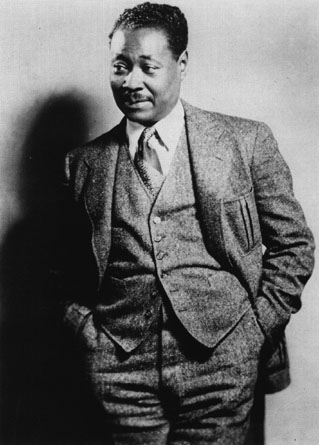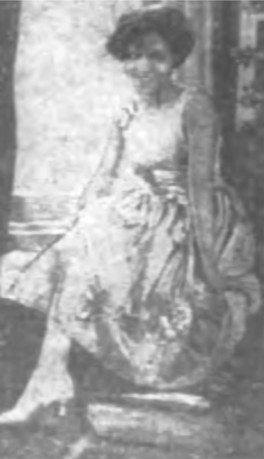Related Research Articles

Festus Claudius "Claude" McKay OJ was a Jamaican-American writer and poet. He was a central figure in the Harlem Renaissance.

The Apollo Theater is a multi-use theater at 253 West 125th Street in the Harlem neighborhood of Upper Manhattan in New York City. It is a popular venue for black American performers and is the home of the TV show Showtime at the Apollo. The theater, which has approximately 1,500 seats across three levels, was designed by George Keister with elements of the neoclassical style. The facade and interior of the theater are New York City designated landmarks and are listed on the National Register of Historic Places. The nonprofit Apollo Theater Foundation (ATF) operates the theater, as well as two smaller auditoriums at the Victoria Theater and a recording studio at the Apollo.

Hubert Henry Harrison was a West Indian-American writer, orator, educator, critic, race and class conscious political activist, and radical internationalist based in Harlem, New York. He was described by activist A. Philip Randolph as "the father of Harlem radicalism" and by the historian Joel Augustus Rogers as "the foremost Afro-American intellect of his time." John G. Jackson of American Atheists described him as "The Black Socrates".

Julius Lorenzo Cobb Bledsoe was an American baritone, a leading figure in the Harlem Renaissance, the first major Black opera singer in the United States, and one of the first Black artists to gain regular employment on Broadway.

Rose McClendon was a leading African-American Broadway actress of the 1920s. A founder of the Negro People's Theatre, she guided the creation of the Federal Theatre Project's African American theatre units nationwide and briefly co-directed the New York Negro Theater Unit.

The Schomburg Center for Research in Black Culture is a research library of the New York Public Library (NYPL) and an archive repository for information on people of African descent worldwide. Located at 515 Malcolm X Boulevard between West 135th and 136th Streets in the Harlem neighborhood of Manhattan, New York City, it has, almost from its inception, been an integral part of the Harlem community. It is named for Afro-Puerto Rican scholar Arturo Alfonso Schomburg.

African-American musical theater includes late 19th- and early 20th-century musical theater productions by African Americans in New York City and Chicago. Actors from troupes such as the Lafayette Players also crossed over into film. The Pekin Theatre in Chicago was a popular and influential venue.

The Lafayette Theatre(1912–1951), known locally as "the House Beautiful", was one of the most famous theaters in Harlem. It was an entertainment venue located at 132nd Street and 7th Avenue in Harlem, New York. The structure was demolished in 2013.

Harry Lawrence Freeman was an American neoromantic opera composer, conductor, impresario and teacher. He was the first African-American to write an opera that was successfully produced. Freeman founded the Freeman School of Music and the Freeman School of Grand Opera, as well as several short-lived opera companies which gave first performances of his own compositions. During his life, he was known as "the black Wagner."

The Harlem Renaissance was an intellectual and cultural revival of African-American music, dance, art, fashion, literature, theater, politics and scholarship centered in Harlem, Manhattan, New York City, spanning the 1920s and 1930s. At the time, it was known as the "New Negro Movement", named after The New Negro, a 1925 anthology edited by Alain Locke. The movement also included the new African-American cultural expressions across the urban areas in the Northeast and Midwest United States affected by a renewed militancy in the general struggle for civil rights, combined with the Great Migration of African-American workers fleeing the racist conditions of the Jim Crow Deep South, as Harlem was the final destination of the largest number of those who migrated north.

Lawrence Chenault was an American vaudeville performer and silent film actor. He appeared in approximately 24 films between years 1920 and 1934; most of his performances were in films directed by pioneering African-American filmmaker Oscar Micheaux. His brother, Jack Chenault, was also a film actor.

Lester Aglar Walton was a St. Louis-born Harlem Renaissance polymath and intellectual, a well-known figure in his day, who advanced civil rights in significant and prescient ways in journalism, entertainment, politics, diplomacy and elsewhere. The New York Times called him an "authority on Negro affairs." Historian Susan Curtis describes him as a man who "advised U.S. presidents and industrialists ... [and] was instrumental in desegregating housing" in New York City. As "America's first black reporter for a local daily," Walton also became the first full-time Black sportswriter and the first Black journalist to cover golf and the nascent sport of pre-1910 basketball.
Hemsley Winfield was an African-American dancer who created the New Negro Art Theater Dance Group.
Henry Francis Downing was an African-American sailor, politician, dramatist and novelist. His cousin was Hilary R. W. Johnson, the first African-born president of Liberia (1884–92).

The Voodoo Macbeth is a common nickname for the Federal Theatre Project's 1936 New York production of William Shakespeare's Macbeth. Orson Welles adapted and directed the production, moved the play's setting from Scotland to a fictional Caribbean island, recruited an entirely Black cast, and earned the nickname for his production from the Haitian vodou that fulfilled the role of Scottish witchcraft. A box office sensation, the production is regarded as a landmark theatrical event for several reasons: its innovative interpretation of the play, its success in promoting African-American theatre, and its role in securing the reputation of its 20-year-old director.

Elise Johnson McDougald, aka Gertrude Elise McDougald Ayer, was an American educator, writer, activist and first African-American woman principal in New York City public schools following the consolidation of the city in 1898. She was preceded by Sarah J. Garnet, who became the first African-American woman principal in Brooklyn, New York while it was still considered a separate city. McDougald's essay "The Double Task: The Struggle for Negro Women for Sex and Race Emancipation" was published in the March 1925 issue of Survey Graphic magazine, Harlem: The Mecca of the New Negro. This particular issue, edited by Alain Locke, helped usher in and define the Harlem Renaissance. McDougald's contribution to this magazine, which Locke adapted for inclusion as "The Task of Negro Womanhood" in his 1925 anthology The New Negro: An Interpretation, is an early example of African-American feminist writing.

Gerri Major was an American journalist, editor, newscaster, publicist, public health official, author and community leader. During World War I, she was a major in the American Red Cross. Thereafter, she became a society columnist and editor for African American newspapers in her home city of New York as well as in Pittsburgh, Chicago, and Baltimore. In 1936, a newspaper reporter said her talent for writing vivid prose, editing, and maintaining a wide circle of influential friends brought her fame and gave her "a unique position similar to that of an arbiter over the local social set." Ebony magazine attested that by the end of the 1930s she had become "one of the best known black women in America." and at the time of her death in 1984, she held joint positions as associate editor of Jet and senior staff editor of Ebony.

Hilda Perleno was an American blues and jazz singer, known for her Broadway appearances in the 1920s and 1930s.
Joyce Mathis was an American soprano who was a concert artist, recitalist, and opera singer from the 1960s into the early 1990s. She is considered a part of the first generation of black classical singers to achieve success in the United States; breaking down racial barriers within the field of classical music. She won several notable singing competitions, including the Marian Anderson Award in 1967 and the Young Concert Artists in 1968. In 1970 she recorded the role of the High Priestess in Verdi's Aida alongside Leontyne Price and Plácido Domingo. Pulitzer Prize-winning composer Ned Rorem wrote his song cycle Women's Voices for her in 1975. In 1976 she created the role of Celestina in Roger Ames's opera Amistad at the John F. Kennedy Center for the Performing Arts. She appeared frequently in performances with Opera Ebony and the Boys Choir of Harlem in addition to touring widely as a recitalist and concert soprano.

Otto Leland Bohanan (1895-1932) was an African-American poet and composer.
References
- 1 2 Although Voodoo was billed as "the first American opera composed by an African American" (New York Amsterdam News (September 5, 1928), p. 6), Scott Joplin's A Guest of Honor was written earlier and performed in 1903 (the score is lost). Although Freeman had written his first opera in 1891, the Joplin opera is thus far the earliest known opera by an African American composed and performed.
- 1 2 H. Lawrence Freeman Papers, 1870-1982, Series I: Musical scores, Rare Book and Manuscript Library Collections, Columbia University Libraries.
- 1 2 3 "Voodoo at 52nd Street Sept. 10," New York Amsterdam News (August 29, 1928), p. 7.
- 1 2 3 "Lawrence Freeman's Opera," New York Amsterdam News (September 19, 1928), p. 16.
- ↑ Dave Peyton, "The Musical Bunch—Freeman's Jazz Opera," Chicago Defender (September 29, 1928), p. 6.
- 1 2 3 4 5 6 7 F.D.P., "Negro Grand Opera Company Pleases in First Performance," New York Herald Tribune (September 11, 1928), p. 18.
- 1 2 "Voodoo, a Naive Melange," New York Times (September 11, 1928), p. 20.
- 1 2 3 "Operatic Notes," New York Herald Tribune (September 9, 1928), p. F7.
- ↑ M.T., "Voodoo, Negro Opera, Has Premier On Radio," New York Herald Tribune (May 21, 1928), p. 11.
- ↑ Richard L. Baltimore Jr., "Broadcasts Negro Grand Opera" New York Amsterdam News (May 23, 1928), p. 8.
- ↑ "Valdo Freeman, Negro Barytone, In Father's Compositions," New York Herald Tribune (June 24, 1928), p. G6.
- ↑ "The Negro Invades The Grand Opera Field," New York Amsterdam News (August 22, 1928), p. 6.
- ↑ "Negro Jazz Opera," Variety (September 5, 1928), p. 56.
- ↑ "Music Notes," New York Times (September 5, 1928), p. 35.
- 1 2 Alfred Frankenstein, "New York Hears First Negro Opera Company Sing "First Opera by Colored Composer"," Chicago Tribune (September 16, 1928), p. G4.
- ↑ Barclay V. McCarty, "Costumers," Billboard (September 29, 1928), p. 41.
- ↑ Barclay V. McCarty, "Negro Opera Is Produced," Billboard (September 22, 1928), p. 10.
- ↑ "Columbia's Rare Book & Manuscript Library Acquires Papers of H. Lawrence Freeman, Musician and Composer | Columbia University Libraries". library.columbia.edu. Retrieved 2024-10-16.
- ↑ Michael Cooper, "Long-Unheard Harlem Renaissance Opera Coming in June," New York Times (May 1, 2015), p. C3.
- ↑ Pierre Key, "Sharps and Flats," Hartford Courant (September 23, 1928), p. D1.
- ↑ Lydia Bass, "Freeman's Opera," New York Amsterdam News (October 3, 1928), p. 9.
- ↑ "Voodoo, Race Opera, Closes After Short N.Y. Run," Baltimore Afro-American (September 29, 1928), p. 9.
- ↑ "Another Negro Opera Planned For Broadway," Billboard (October 6, 1928), p. 8.